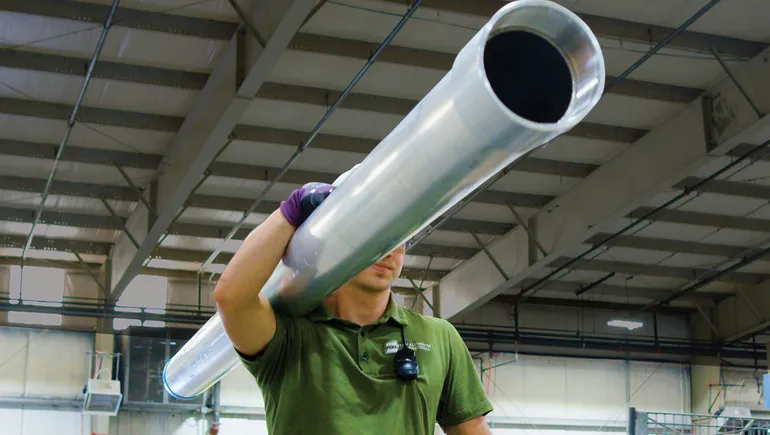For decades, the standard choice for electrical wire raceways was galvanized steel conduit. However, in 2024, more and more building owners, designers and contractors are choosing aluminum – both rigid aluminum conduit and aluminum EMT (electrical metallic tubing) – over galvanized steel, for its sustainability and a number of other advantages.
Aluminum conduit and EMT can be used in almost every application where galvanized steel is used, and meets the same UL standards as steel conduit.
Lower weight means faster installation
At one third the weight of galvanized steel, aluminum conduit and EMT makes installation faster and easier, reducing labor requirements and costs. Aluminum conduit and EMT are easier to lift and carry – often requiring just one person when two or more would be needed with steel. Aluminum also makes onsite fabrication faster and easier, including cutting, bending and threading, allowing projects to be completed in less time with the same or fewer people.
Recycled aluminum is the sustainable choice
For those interested in sustainable building products, aluminum conduit and EMT is the ideal choice. It is made of recycled aluminum and is 100% recyclable at the end of the building’s life. The significantly lower weight of aluminum also allows it to be shipped much more efficiently, reducing fuel usage and emissions. In addition, aluminum scrap is easy to recycle (and has a higher monetary value than steel), so it should never end up in a landfill.
Reduced material costs
The lower cost of aluminum alloy, along with the aluminum extrusion process, results in aluminum conduit and EMT offering significant cost savings over galvanized steel products (one of the few cases where the more sustainable product is less expensive). The lighter weight also results in lower shipping costs when compared to steel. Plus, the immediate resale value of scrap aluminum also helps to offset material costs.
Increased jobsite safety
Another important topic in today’s construction industry is safety. At one-third the weight of steel, it’s easy to see how much safer it is for contractors to lift, carry and install aluminum conduit and EMT compared to steel. The significantly lighter weight means less risk of injury, both related to lifting and dropping. The less effort required also means less fatigue, which is one of the most common causes of jobsite injuries and a key drain on productivity. In a labor market in which skilled workers are more valuable than ever, a safer jobsite using aluminum conduit can offer a major advantage.
About Penn Aluminum Conduit & EMT
Penn Aluminum, a Marmon/Berkshire Hathaway company, has been in business for more than 100 years, and has been focused specifically on aluminum tubing for the last 50+ years. Prior to entering the conduit market, the company specialized in providing innovative engineered solutions for the demanding automotive, HVAC and defense industries, where high quality and extremely tight tolerances are mandatory. A majority of vehicles manufactured in the U.S. contain Penn aluminum tubing in their HVAC systems.
As the demand for sustainable building products grew, Penn saw an opportunity to serve an unmet need for aluminum conduit and EMT. After years of research and development, refining their aluminum alloy to provide consistent and reliable bending and wire pulling, the company introduced its products to the construction market in 2021 and found immediate acceptance – in major hospitals, schools, stadiums, office buildings and other project types.
All Penn Aluminum Conduit & EMT products are UL listed and manufactured in America, and produced from domestic recycled aluminum. The company’s state-of-the-art manufacturing facility (which is ISO/IATF 16949 certified) in Southern Illinois allows fast and efficient shipping throughout the country. For more information, visit pennconduit.com.
